Happy Lunar New Year from the USC US-China Institute!
California Counts
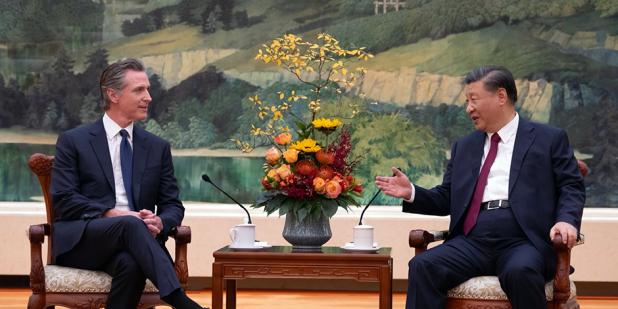
California Governor Gavin Newsom traveled to China last month. This week the top U.S. and Chinese officials on climate change, John Kerry and Xie Zhenhua, met at Annenberg Sunnylands in Southern California this week. Next week Chinese leader Xi Jinping will come to California for the Asia Pacific Economic Cooperation summit. Only four countries, including the rest of the U.S. and China, have economies larger than California's. And relatively few large economies are as committed as California to combating climate change. Newsom, like his predecessors Arnold Schwarzeneggar and Jerry Brown, aims to strengthen climate cooperation and to boost economic ties with China.
Newsom and his hosts were mindful the trip came as face to face meetings of American and Chinese officials have increased and that there could be a lot of attention. Newsom brought Charles Ommanney, an accomplished photo-journalist along. Print and broadcast outlets sent reporters and the trip was extensively covered in China. Newsom was accompanied by Dee Dee Myers, director of the Governor’s Office of Business and Development. Myers, of course, was President Clinton’s White House spokesperson for two years.
All scripts can fall apart. Video of Newsom's stumble on a school basketball court generated a lot of comment, but both the governor and the student he landed on came up laughing. Newsom met with national, provincial and city officials and businesspeople focusing on what can be done to increase the production of renewable energy and to promote greener transportation.
Newsom reached Beijing midway through his trip and was invited to meet with Xi Jinping, Foreign Minister Wang Yi and others. Chinese state media reported that Xi spoke fondly of his earlier trips to California and stressed the utility of sub-national cooperation on climate change and other issues. Newsom told reporters that “Divorce is not an option. The only way we can solve the climate crisis is to continue our long-standing cooperation with China.” His office said that he also raised concerns about human rights and policies in Hong Kong, Tibet and Xinjiang and that he asked about David Lin, a California pastor imprisoned in China for many years. As it had a decade ago, China’s National Development and Reform Commission agreed to a memorandum of understanding with California to further nourish economic growth while cooperating to address environmental issues.
China’s Jiangsu province is a world leader in renewable energy technology and infrastructure. Most attention has gone to its dominance in solar panel production, but it’s a leader in wind turbines as well. California and Jiangsu became sister state-provinces in 2011, but signed MOUs on energy earlier and as recently as 2019. Newsom visited the Goldwind turbine factory and viewed an off-shore wind farm. A third of Jiangsu's wind power comes from off-shore turbines. It's China's leader in this regard. California aims to rely on renewable sources to generate 90% of its electricity by 2035. It's got a ways to go. In 2022, 45% was generated by renewable sources. But the state is ahead of China and the rest of the U.S. in this regard. Although China's renewable energy production is the most anywhere, its rapid development means it remains heavily dependent on coal-generated electricity. Newsom is anxious for California to emulate Jiangsu and other regions with off-shore wind farms. California's steep ocean shelf, however, means such wind farms would have to float rather than being built into the ocean floor.

Goldwind turbines installed near Nantong, Jiangsu; Credit: Goldwind.
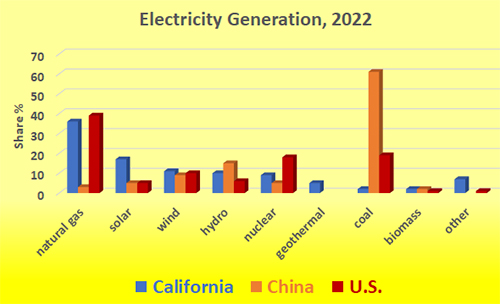
Data: Energy InstituteStatistical Review of World Energy; USCI chart
Road transportation is responsible for 12% of global greenhouse gas emissions. China and California have been pioneers in trying to move to cleaner alternatives. During his China sojourn, Newsom visited both BYD (Shenzhen) and Tesla (Shanghai) operations. Globally, Tesla leads in total battery electric vehicle sales (BEV), but BYD’s BEV and plug-in hybrid (PHEV) sales are greater.
BYD, with its North American headquarters a dozen blocks north of USC, has been making batteries and electric buses in Los Angeles County since 2013. More than 500 work at the unionized plant. More than 500 BYD electric buses from the factory are being used by American transit systems, tour operators and others.
Tesla’s plant in Fremont, California became the top auto plant in the U.S. in 2021. It turned out 8,600 cars a week. Tesla’s newer factory in Shanghai employs 20,000 people. It produced over 12,000 cars a week in 2022, many for export. Almost 50,000 people work for Tesla in California and this year the company opened its new global research and development headquarters in Silicon Valley.
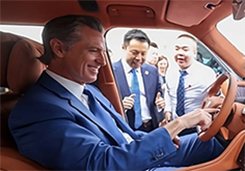 |
 |
| BYD, Shenzhen | Tesla, Shanghai |
At BYD, he drove a BYD Yangwang U8, a PHEV SUV that can execute a 360° pivot turn (essentially a U-turn in place). It made an impression. Newsom said, "This is another leap in the technology, I mean, next level leap.” BYD sells many affordably-priced priced EVs in China, India and other markets, but this new vehicle costs more than $150,000.
At Tesla, Newsom went for a short test drive and then talked about autonomous vehicles as the future. Asked about worries people have about potential safety issues with such cars, Newsom said, "I think we are going to look back in 20 or 30 years and go why were we allowed to drive and allow thirty-plus-thousand Americans to die every single year in accidents?”
Newsom inherited the plan to build a high speed rail linking Northern and Southern California from Arnold Schwarzeneggar and Jerry Brown. Newsom’s predecessors were impressed with systems abroad, including China’s 20,000 mile network. Newsom is focusing on building the middle portion of the project. Even so, that portion of the effort is over budget. Last fall several former project leaders told the New York Times that political choices have doomed it. Even so, this week the National Resources Defense Council released a report ranking states on how well their transportation systems and plans are doing to address climate change, equity, vehicle electrification and expanding transportation choices. NRDC ranked California #1 with 87 points. Second place Massachusetts had 69 points.
Mass transit is improving in California cities. Los Angeles, for example, is expanding its subway and light rail lines. New subway cars were manufactured in China and are being assembled in Massachusetts. The city hopes to have these projects running in time for the 2028 Olympics. Los Angeles will be the first city to have hosted the games three times.
*****
Chinese and Americans tend to think of tourism, technology and entertainment when they think of California. The state’s prowess in agriculture is often neglected, even though California agriculture leads the nation. It produced $51 billion in agricultural products in 2021. Iowa was a distant second place at $35 billion. California exports much of what it produces (44% in 2021) and China is its third leading market (over $2 billion) after Canada and the European Union.
Wine may be California’s most glamorous agricultural export, but the biggest value exports to China are pistachios and almonds. Since 2015, they account for more than half of the value of all agricultural exports. Former House Republican leader Kevin McCarthy’s district is the top producer of those nuts. Wine exports peaked at $185 million in 2017 and accounted for just $103 million in 2021.
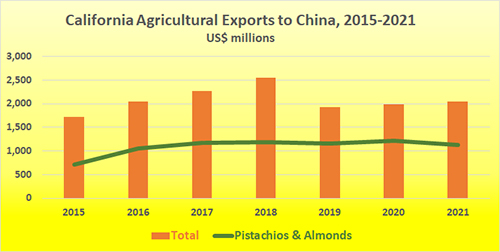
Data: California Department of Agriculture; USCI chart
Last week, the U.S. government officially participated in China’s International Import Expo for the first time. Many American companies and organizations were represented. The California Almond Board was among them.
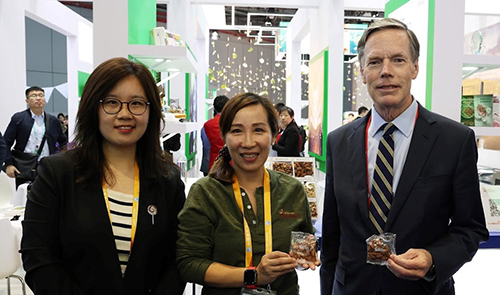
Amb. Nicholas Burns visits the Almond Board of California booth in Shanghai, Nov. 2023. Credit: U.S. Consulate
*****
Most know that the China market is very important for California’s entertainment industries. Some films do better in China than in North America, but in recent years Chinese films outearn most American films. Of course, China’s government restricts which films may be screened and when, but the production values of Chinese films have risen and tastes are evolving. For two pandemic years, China’s box office exceeded North America’s, but last year’s zero-covid policy in China caused a 40% contraction in box office receipts there.
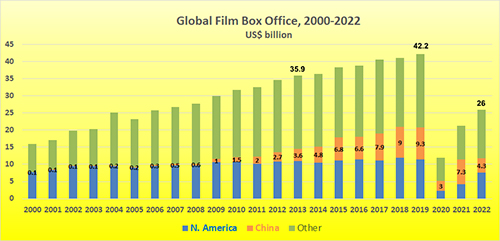
Data: Motion Picture Association reports; USCI Chart
In 2023, Chinese audiences are filling theatres, mainly for domestic films. Hollywood’s products have not mostly disappointed. One franchise, Fast X, did well and Oppenheimer surprised many with its success. But global giants such as Barbie and Super Mario Brothers failed to earn $50 million in China, while bringing in more than $1 billion worldwide.
California is a major force, second only to China, in the video game industry which is several times larger than film. Prominent California video game creators include Activision Blizzard, Electronic Arts and Riot Games, a subsidiary of Tencent, China’s most valuable company. Each publishes games that have succeeded in China. Getting approval to offer any game in China can be difficult and requires localizing the content and partnering with a Chinese firm. Activision Blizzard’s partnership with Chinese giant NetEase ended this year. Electronic Arts and Tencent recently released their new soccer game FC 24. Riot Games’ China offerings include the perennially popular League of Legends and the newly approved Valorant.
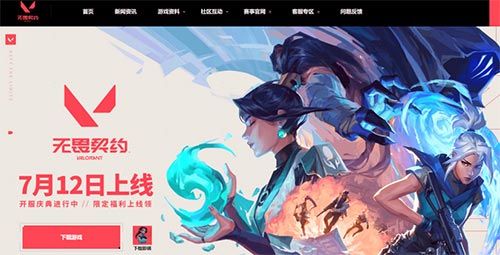
Valorant released in China this summer.
*****
California’s ports, especially those of Los Angeles and Long Beach, ship these products to China and handle the bulk of America’s imports from China. Combined, the ports handled $182 billion worth of goods from and to China in 2022, up 15% from 2020. Covid-19’s impact on the ports was profound. Workforce and equipment shortages slowed unloading ships and moving containers out of the ports. For a time in 2021, more than 100 ships were anchored nearby waiting for a chance to unload. Those problems have been resolved.
Total direct trade between China and the United States has declined. Trump and Biden administration policies aimed to do this. Some of this decline, however, is illusory. China supplies other places with essential inputs or even complete goods that are then passed along to the U.S. but credited to the third economies. Vietnam and Taiwan top this list. Between 2017 and 2022, the value of goods passing through the ports of Los Angeles and Long Beach dropped 6% in the case of China, but rose 83% in the case of Vietnam and 52% in the case of Taiwan.
At the same time, trade with China continues to dwarfs all other overseas trade and this contributes to climate change. This fall, the ports of Los Angeles, Long Beach and Shanghai announced plans to create a “green shipping corridor.” Collaboration is voluntary and involves the governments and private companies. The aim is to reduce emissions in port, in transit and in transfer to ground shippers.
*****
In addition to exporting billions in goods to China, California exported $8 billion in services in 2021. This represented a step up from 2020 but significantly down from 2019 when California exported $11 billion in services to China. Clearly covid-19 travel restrictions and the drop in Chinese students enrolling in U.S. schools was a big factor. The number of students from China dropped from 372,532 in 2019 to 290,086 in 2021, a decline of 22%.
| Top California Services Exports to China | 2019 | 2021 |
| education | $2.4 billion | $1.8 billion |
| personal travel and tourism | $1.6 billion | |
| industrial processes royalties | $926 million | $1.1 billion |
| business travel | $594 million | |
| ocean shipping/port services | $559 million | $735 million |
| audio/visual services | $688 million | |
| Total all services exports | $11 billion | $8 billion |
California traditionally enrolled more students from China than any other state, so the impact of declining enrollment has an economic impact. (USC’s enrollment from China, however, has remained steady.) In 2019, almost 3 million travelers from China visited the U.S., with Los Angeles being their top destination. However, due to factors such as lack of flights, visa challenges, and political tensions, the number of Chinese tourists in Los Angeles dramatically dropped to just 110,000 last year. During his visit, Newsom joined a celebration of increased United Airlines flights between San Francisco and Shanghai and Beijing.
*****
California counts on the global stage and is certainly key to the multifaceted U.S.-China relationship. This will be on display this week with the Asia Pacific Economic Cooperation summit and the meeting between Joe Biden and Xi Jinping.
Click here to subscribe to the USCI newsletter. It includes information about upcoming events, professional development opportunities, and quick looks at important issues in U.S.-China relations and trends in contemporary China. Previous issues are available here.
Featured Articles
We note the passing of many prominent individuals who played some role in U.S.-China affairs, whether in politics, economics or in helping people in one place understand the other.
Events
Ying Zhu looks at new developments for Chinese and global streaming services.
David Zweig examines China's talent recruitment efforts, particularly towards those scientists and engineers who left China for further study. U.S. universities, labs and companies have long brought in talent from China. Are such people still welcome?






